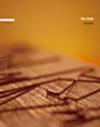Ken Ikeda, "Kosame"

Unlike his previous works, which were often emphasizing sine waves and other synthetically derived sounds, Kosame is all about the world around us and the sounds of everyday life. Combining recordings of opening windows and boiling water with home made instruments and classic synthesizers, the result is a world of sound that may not resemble "songs" per se, but instead an aural study of our surroundings.
Ikeda has created this album to explore the concept of "yuragi," which roughly translates to "fluctuation."In this case, fluctuation in the sound of society, as well as fluctuation of instruments:the varying tonality of home made rubber and wood instruments, as well as the unpredictability of analog synthesizers.On "Kosame (Drizzle)" the various nuances of the human voice is used:Ikeda's reading of the novel Mizuumi is cut up and spliced to focus on the movements of the mouth and the sounds of saliva more than the voice being extruded.
On "Hakuchu (Daylight)," the old creaking sounds of the window in Ikeda's childhood home create the primary texture, mixed with birdlike flutters and clipped fragments of static bursts.With the frail strums and sparse arrangement, there is a nostalgic but sad color to the sound.The same emotions appear in "Marebito," which is dedicated to Ikeda's late grandmother.The bird-like synth chirps and mournful string plucks create a dynamic, but sorrowful series of textures.
Tracks like "Mikazuki (Crescent)" have a less emotional color to them, but provide the same quality of sound exploration.In this case, an empty champagne bottle is used like a miniature gamelan, creating percussive clinking sounds, and also as a reverb chamber to turn dripping water into cavernous noises, combined with hissing sounds from blowing on the bottle.The result is a sonic microcosm derived from a single instrument.
While "Seijaku (Stillness)" is based upon a singular common sound (the boiling of water), here it is juxtaposed with a variety of other effects and instruments to create a broader spectrum.The rattling and bubbling noises of boiling water change in consistency throughout, but are paired with tentative string notes from homemade instruments and the occasional bleeping synthesizer.The boiling is the focus, becoming more and more forceful as the piece concludes, but never overshadows the other sounds.The closing "Tobira (Gate)" uses the field recordings of Ikeda walking around, picking up wood and nails that are used to create an instrument used during the piece, leading to a subtle collection of friction sounds created between strings and nails. While it can be a challenging listening experience, Kosame on the whole is definitely a rewarding one.
samples:
 




